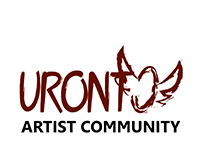
02 Jan URONTO Residential Art Exchange Program- Episode 08
A little known Jaminder house at Naogaon District in Bangladesh called Dubolhati, is being explored by more than 25 multidisciplinary artists coming from 8 different countries by mid Nov 2019. It has become the official venue for 8th and 9th Episode of Uronto Residential Art Exchange Programs. URONTO did two episdoes back to back at this gigantic palace in Naogaon. The 8th Episode took place from 15-26 Nov 2019.
URONTO invites artist and creative collaborators across all disciplines to explore a self-directed Residential-Art-Exchange program for 12 days, responding to the diverse ruins of Dubolhati Palace in response to be question of “Where is the past in your future?” .

Rajshahi Division is one of the eight first-level administrative divisions of Bangladesh. It is bounded by WEST BENGAL state of India and DINAJPUR and GAIBANDHA districts on the north, RAJBARI and KUSHTIA districts on the south, JAMALPUR, TANGAIL and MANIKGANJ districts on the east, West Bengal-state of India on the west.
Naogaon district is located in the northern part of Bangladesh.
The word Naogaon has been origin from Nao (New- a french word) Gaon (village). So, the word Naogaon means new village. By the passing of age the region was turned into Naogaon city and finally Naogaon district. Once, the region was included in Pundrabardhana. It is also a part of Barendra region.
The ancient inhabitants of the region were the inheritor of Pundra nation. Indigo Rebellion (1859-62), Peasant Revolt against the landlords (1883) etc are the remarkable chapters of the region. The entire Rajshahi Division was famous for prominent jamindari territory in Bangladesh. Naogaon district under Rajshahi Division had several Landlords ruling there but majority ruler was Hindu. After the eviction of Jamindari customs most of the Jamindar went back to India leaving behind their belongings specially the palaces and so the history of the palaces is mostly gone with them. Among the landlords in Naogaon district Dubolhati was significantly the pioneering one.
Dubolhati Jamindari spread from Naogaon, dinajpur, Bagura upto some parts of India too. While the permanent settlement process British Lord Cornwallis leased his land to Krishnonath in exchange of 14,495 Taka. By 1853 Horonath Ray Chowdhury, son of Krishnonath took the state in his hand and made a lot of development in the area, like introducing scholarships for students, building schools, Govt. offices, Medical college and hospital, 16-wheel chariot and developed a lot financially.
The period of Horonath Ray Chowdhury was the most glorious years of Dubolhati Jamindari. He was awarded with the title “Ray” in 1875 and the title “Bahadur” in 1876. In the same year the English medium free school was named after him.
Dubolhati Jomidar Bari/Palace is located at the Dubolhati union of Naogaon district, 7 km distance from Noagaon city. This is around a 200 years old building situated in around 2.45 acre area, some documents say its 5 acres including the garden area around it. Compare to the other Jamidar houses/Palaces from Bangladesh, this one is a massive one. But unfortunately, the condition of this one is very poor and it looks like it will collapse badly in any moment. It was built by the second half of the 19th Century during the Horonath Ray Chowdhury ruling period. The palace was constructed with Brick, lime stones, Iron and expensive Shal Wood. The entire structure contains a lot of Iron bars and wooden doors and windows which are robbed gradually after the palace being abandoned.
The palace is formally two-storied but in few corners, there are extra rooms on the top. The entire structure can be divided into two Sections: Indoor and Outdoor. In the outdoor section there was two segments: the Nachmanahl/Natmancha (dance/performance stage), the official court chamber section, the indoors were the main residential section and the Cooking area. In both floors, the sections were same.
There is a well in the palace to collect water. At the entrance, there are tall pillars like any Greek structure in history. After entering few steps away is the Nachmahal, that is the main entertainment area of the palace where performers entertained landlords and officials with traditional dances. Dubolhati is a massive structure and a large portion was used for Court chamber where all kind of official works and tax collection accounts were maintained. In that period, many of the employees were resident at the palace to maintain the daily court works smoothly. In the residential indoors there are big bedrooms with beautiful balcony with each of them. The entire palace is designed beautifully keeping access of light and wind form every side.
Local people says the palace had about 300 rooms and accommodated a large number of people, the numbers of the rooms might not be authentic but a large group of people indeed stayed here. It is popularly known that there was an ivory throne which the British took with them. The present situation of the palace is terrible and still various groups of the society is looting the bricks, irons and other possible elements form the palace.
The Archeology department had a board in front of the area but no preservation initiative has been taken so far. The designs around the palace significantly represents glory and pride.
The structure is a bright example of Indo-European design. Corinthian and Tuscan pillars can be seen in fronts of the palace and the balcony area, also Venicien influence in the wooden windows, Greco-Roman classical influence in the sculptures on the top of the entrance, Muslim influence in the motifs of the design with grape leaf pattern and other ornamentation is also observed there. Other than this massive main palace there was a small villa near to it as part of this main palace. That villa was locally called Hawa-Khana, Hawa is Bengali of wind.
The selected artists in the 8th episode were Chandrayee Dey/India, Deepak Kumar Yadav/India, Elodie Guignard/France, Kazi Toufikul Islam/BD, Manir Mrittik/BD, Nabil Wrahman/BD & NYC, Nisha Rachel Philip/India, Rabia Williams/Spain/ NYC, Rubi Karmakar/India, Sarban Chowdhury/India, Saria Saguaro/BD, Sounak Das/BD, Taiara Farhana Tareque /BD, Tanvir Alim/BD, Ameio Roy(BD), Muna Hossain(BD), Mohammed Ferdous(BD). Part of the contributing theater team “Prachyanat” from Dhaka besides Toufikul Emon were Rocky khan, Shahin Saidur, Tahadil ,Shamim Srabon and the participating performer form the local film society “Zahir Rayhan Chalachitro Shangshad” were Khorshed Alam Raju, Firoz Hossain, Polash Kumar Das, Poritosh Shaha, Sharifuzzaman, Sakib Islam.
Rabia Williams/Spain & NYC, M. Shafayat Hossain(BD), Helena Uambembe/South Africa and Simangaliso/South Africa were also among the final selected artist but could not join for unfortunate situations at the last moment.
Like always all the artists explored the local founding materials as much as possible to shape up their imaginations aligning the stories about the space. URONTO has been executing this program successfully since the beginning. They have done 7 exclusive episodes in 7 different districts around Bangladesh with more than 100 artists participating till now.
Uronto explored one of the largest site ever for them with a large group of artist in this eight episode. The participating artists investigated deeply into the stories of the palace through intense community involvement. The main source of information came from a 92 years old man named Faruk Mandal who have worked in the palace himself and few other people who have seen the king and his family members just before their departures from the house. Layers of different narratives came out and the artists became more and more connected to the space.



Everyday activity of the artists were to get involved in the community around the location and find narrative for work inspirations, then at the end of day they would come together and share their day long experiences with all and brainstorm different aspects of understanding the local cultural history. Some of them have visited the local women in the area regularly to shape up their works, some spent hours in the local tea stall to listen to diverse stories form the local crowd, some artists tried to connect with local craftsmen to collaborate and shape up their work. Few of the artists were very active from the first day about what they want to do and few artists could shape their work almost at the end days too. All of such fractions are very normal part of the residency happenings and contributes to the exchange of creative co-creation.
A day long workshop with local children from Naogaon city and Dubolhati village was arranges in association with local cultural group of Noagaon. Also a film screening on S M Sultan was arrange for local audience and artists too again in collaboration with the Local cultural group. It must be mentioned that “Zahir Raihan Film Society” has been the most active and contributing cultural group from Naogaon with Uronto. Also the local cultural group “Udichi” (which is a very old and reputed local cultural organization) has been very helpful. Another workshop at the house of a local Malakar (craftsman of Shola) from Naogaon- Shirish Chndra, was arrange by Uronto. Participating artists learned about the local traditional techniques of different crafts out of “Shola”. (Shola is a spongy stem of “Shola plant” almost like styrofoam but is different in shape and uses.) and paper.
The day before the open studio day, on 26th November 2019, the performance by artist Nisha R.P. took place as part of the durational intervention. Then on the last day of the 8th episode, as part of the Open Studio day The theater play took Place.
The open studio on 27th November 2019, was a large gathering of local village people, Naogaon city people, local cultural activists, artists, school children, Local enthusiasts and families living near to the Dubolhait Palace. More than 600 people gathered and visited the open studio day. The theater play was center of attraction with other amazing works done by the artists. Different layers of art works were merged into the rustic walls and environment of the palace. Local audiences were thrilled to see such engagements of artistic expressions with the place for the first time. Photographic works with projection on walls, installation in different corners on the palace, minimal visual alignment, public sculpture etc were few among the works that were displayed at the open studio day. Despite all the challenges of not able to have enough logistics in such rural area, all the artists expressed their best and could connect with local audience through their work. Also after the palace became abandoned, this was the first time the indoor theater stage (Nahcmahal) was re-activated by the contributing performer from Prachyanat at URONTO.

Many important educator, cultural activists, athletes, poets and artisans visited all of the art works and thoroughly enjoyed and shared their blessings and love for all the artists. The ending of eighth episode was also the beginning of the 9th episode at the same place so few of the artists of the 9th episode were present too at the open studio day as pre-arrival.
Detail of all the works done by artists in the episode can be found in archive section in this website under the tag of 8th episode. Also more details about the workshops are given in activities section separately.

Coverage of the 8th & 9th episode of URONTO residential art exchange program- The Daily Sun | Daily Karatoa | Kaler Kantha
URONTO is hosting site responsive residential art exchange programmes since 2012, within disused or abandoned spaces and heritage buildings to document cultural memories and brand Bangladesh globally through multidisciplinary artists’ collaborations. URONTO’s activities not only provide much-needed opportunities for emerging artists to expand their working practice and collaborate with international artists, but through each residency, they create an alternative documentation about the history of the selected site before it’s demolished and forgotten.
The Project invite artists and practitioners through open call and selects then through a curatorial board created newly for every Episode. It is an international program open for all kind of discipline.





















No Comments